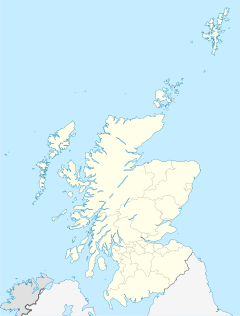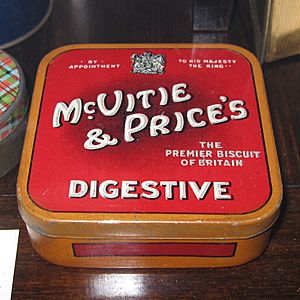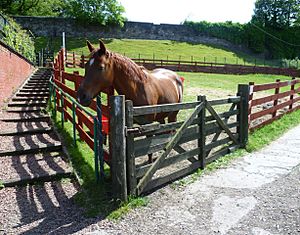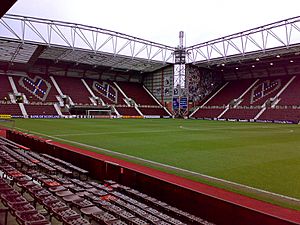Gorgie facts for kids
Quick facts for kids Gorgie |
|
|---|---|
 Gorgie Road |
|
| OS grid reference | NT2372 |
| Council area |
|
| Country | Scotland |
| Sovereign state | United Kingdom |
| Post town | Edinburgh |
| Postcode district | EH11 |
| Dialling code | 0131 |
| Ambulance | Scottish |
| EU Parliament | Scotland |
| UK Parliament |
|
| Scottish Parliament |
|
Gorgie is a busy area in Edinburgh, Scotland. It is located west of the city centre. Gorgie is next to areas like Murrayfield, Ardmillan, and Dalry. It is a place where many people live.
Contents
Understanding the Name Gorgie
The name Gorgie likely comes from an old Brythonic word. Some people think it means "upper wedge." This might describe the shape of the land. The land narrows between the Water of Leith river and the Craiglockhart hills. Another idea is that it means "big field" in an old language called Cumbric.
Gorgie's Past: A Look at History
Gorgie has a long history, dating back to the 1100s. In 1236, a knight named Sir William Livingston owned the area. Later, in 1799, the Cox family bought most of the land. They built a glue factory there. This factory was later replaced by a telephone exchange in 1969.
From 1527, the landowners lived in Gorgie House. This house was on Alexander Drive. It was taken down in 1937 to make way for a cinema and new homes. Gorgie grew slower than nearby Dalry. Because of this, a large pig farm in Gorgie kept running until 1885. A street called Robb's Loan is named after Robert and James Robb. They farmed in Gorgie for a long time. By 1800, only a small part of Gorgie had houses. It also had a school and a church.
Gorgie's Industries and Factories
In the late 1800s, many people started drinking grain whisky. This led to a need for large whisky producers. In 1885, several whisky blenders started the North British Distillery Company. They bought the old pig farm and built a distillery. This distillery made a lot of whisky.
The distillery was connected to the Edinburgh Suburban and Southside Junction Railway. This led to new homes being built in Gorgie. Streets like Stewart Terrace and Wardlaw Place were built around 1888. Many apartment buildings, called tenements, were also built. Some of the last tenements in Gorgie were built in 1898. Even with all this building, the western part of Gorgie stayed mostly rural until the early 1900s.
The famous biscuit company McVitie & Price Ltd started in Edinburgh in 1830. They moved to Gorgie and built the St. Andrews Biscuit Works factory in 1888. The factory burned down in 1894 but was rebuilt that same year. Many believe the digestive biscuit was invented here! The factory closed in 1969. After that, an electronics factory called Ferranti used the buildings until the 1980s. Other businesses in Gorgie included Cox's glue factory and the Caledonian Brewery.
Places to Worship in Gorgie
Gorgie has several churches. Gorgie-Dalry Parish Church started as the Tynecastle church in 1891. St. Martin of Tours church is part of the Anglican faith. Gorgie Gospel Hall belongs to the Open Brethren Christian group. Gorgie Mission Church opened in 1908. Since 2008, Destiny Church has met in a building that used to be a Bingo Hall.
Gorgie Today: A Modern Community
Most of the big factories in Gorgie closed between the late 1960s and mid-1980s. This caused many people to lose their jobs. However, many old buildings have been fixed up. This has brought new types of businesses and people to the area. Gorgie still has many smaller local shops. Tynecastle High School serves the young people in the area.
Gorgie City Farm was started by local people in 1982. It was built on an old railway yard. The farm was a community project. Its goal was to teach people about farming, gardening, and old crafts. The farm closed in 2023. However, local groups are planning to open it again in the future. In 2012, Gorgie was where a health issue called Legionnaire's Disease started. It was thought to come from factory cooling towers.
Who Represents Gorgie?
The Gorgie area is part of a voting district called Edinburgh South West. This district sends a representative to the UK Parliament in Westminster. Currently, the representative is Joanna Cherry from the Scottish National Party.
For the Scottish Parliament, Gorgie is in the Edinburgh Central district. Angus Robertson of the Scottish National Party represents this area.
Gorgie is also part of the Sighthill/Gorgie ward. This ward elects four councillors to the City of Edinburgh Council. These councillors help make decisions for the local area.
Gorgie's Population: Demographics
Here is a look at the different groups of people living in Gorgie compared to all of Edinburgh:
| Ethnicity | Gorgie | Edinburgh |
|---|---|---|
| White | 88.8% | 91.7% |
| Asian | 7.0% | 5.5% |
| Black | 2.2% | 1.2% |
| Mixed | 0.6% | 0.9% |
| Other | 1.4% | 0.8% |
Getting Around: Transport in Gorgie
Gorgie was once crossed by two railway lines. It had a train station called Gorgie East Station. This station opened in 1884. It served the area until 1962. Passenger trains stopped running on this line as part of a plan to cut railway costs. This plan was known as the Beeching Axe.
The old station is no longer there. However, the railway line is still used today. Freight trains use it to avoid Edinburgh's main stations. Sometimes, passenger trains that are rerouted also use this line.
The Future of Transport
A local group called the Capital Rail Action Group (CRAG) wanted the railway line to open again for passengers. They suggested it could be a commuter train service. Or, it could be a light rail system, like an extension of the Edinburgh Tram Network. In 2007, they sent a request to the Scottish Parliament. But in 2009, transport planners said no. They thought it would cost too much money.
Home of Heart of Midlothian F.C.
Heart of Midlothian F.C. is a famous football club. It was started in 1874. The club played in different places before moving to Gorgie in 1881. Their first pitch in Gorgie was where Wardlaw Street is now. At that time, Gorgie was considered "out of town." So, Hearts sometimes offered two matches for the price of one. Or, they made tickets cheaper than their rivals, Hibernian.
In 1886, Edinburgh was growing. New buildings replaced the old football ground. Hearts then moved across Gorgie Road to their current location. They still play there today at Tynecastle Park in the Scottish Premiership.
Famous People from Gorgie
See Also
- Gorgie-Dalry





